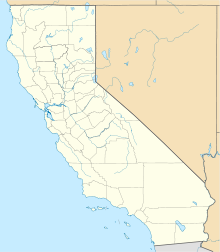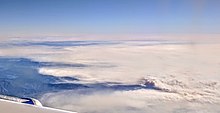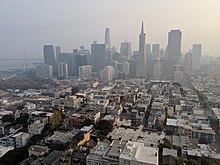Then there was another problem. A Traffic jam on the only road out of the valley that was paved. But, people who abandoned their cars and trees that might have fallen down while burning blocked this road until a Bulldozer from Cal Fire unblocked the way. Many of the cars were melting especially the plastic around the lights front and rear and some of the door and side mirrors were melting.
So, even if you knew something was wrong and were trying by running or riding a bicycle or a motorcycle or car or truck out of the area your way often was blocked by panicked abandoned drivers caught in traffic or trees on fire coming down until bulldozers could push everything out of the way so you could drive your melting car (from the fire) out of there. These were the lucky ones who survived and got away without being burned alive.
The Camp Fire started at sunrise and was first reported at 6:33 AM on Thursday November 8th 2018.
begin quote from:
The fire began on the same day as the Woolsey Fire and the Hill Fire in Southern California. OnNovember 25, 2018, the fire was 100% contained according to the state fire official.
Camp Fire (2018)
| Camp Fire (2018) | |
|---|---|

The Camp Fire as seen from the Landsat 8satellite on November 8, 2018
| |
| Location | Butte County, California |
| Coordinates | 39°50′51″N121°23′42″WCoordinates: 39°50′51″N 121°23′42″W |
| Statistics | |
| Cost | $7.5–$10 billion (insured losses)[1][2] |
| Date(s) | November 8, 2018 – November 25, 2018 |
| Burned area | 153,336 acres (62,053 ha)[3] |
| Cause | Under investigation |
| Buildings destroyed | 18,793[4] |
| Fatalities | 85 civilians[3] |
| Non-fatal injuries | 12 civilians and 5 firefighters[5] |
| Missing People | 249[6] |
| Map | |
The Camp Fire is the deadliest and most destructive wildfire in California history.[7] It is also the deadliest wildfire in the United States since the Cloquet fire in 1918,[8] as well as the sixth-deadliest U.S. wildfire overall.[9] Named after Camp Creek Road—its place of origin[10]—the fire started on November 8, 2018, in Butte County, in Northern California. The fire caused 85 civilian fatalities,[3] injured 12 civilians and five firefighters, covered an area of about 153,336 acres (62,053 ha), and destroyed 18,793 structures, including 13,696 single-family homes, 276 apartment buildings, and 528 commercial buildings, with most of the damage occurring within the first two days.[11] As of November 19, insured damage was estimated to be $7.5–10 billion.[1][2]
The fire forced the evacuation of Paradise, Magalia, Centerville, Concow, Pulga, Butte Creek Canyon, and Yankee Hill and threatened the communities of Butte Valley, Chico, Forest Ranch, Helltown, Inskip, Oroville, and Stirling City.[12][13] Within the first day, the fire essentially destroyed the community of Concow and the town of Paradise,[14] incinerating homes, businesses, churches, a hospital, schools, and a rest home.[15][16] The fire began on the same day as the Woolsey Fire and the Hill Fire in Southern California.
On November 25, 2018, the fire was 100% contained according to the state fire official.[17]
Contents
Timeline
The fire started at sunrise on Thursday, November 8, 2018, and was first reported at 6:33 a.m. PST, near Pulga, California, near Camp Creek Road in Butte County, California. Soon after the ignition of the Camp Fire, initial attack firefighters were dispatched to a report of a brush fire under Pacific Gas and Electric Company (PG&E) power lines near Poe Dam on the Feather River. Arriving 10 minutes later, the first units on scene observed rapid fire growth and extreme fire behavior due to low humidity and high winds in the area. The National Weather Service had issued a red flag warning for most of Northern California's interior, as well as Southern California, through the morning of November 9. PG&E reported that power lines were down.[18] Shortly after the fire erupted, the Butte County Sheriff's Office ordered the evacuation of Paradise.[19] Other locations were also issued evacuation orders, while others were issued evacuation warnings, and emergency shelters were established.[20][21]
The speed of the fire prevented most residents of Concow and many residents of Paradise from evacuating before the fire arrived. The fire spread so rapidly that firefighters stopped attempting to control the flames, and instead sought to help people get out alive.[13] By 8:00 p.m. PST on November 9, the fire had burned 20,000 acres (8,100 ha) and threatened about 15,000 structures,[22] with wind speeds approaching 50 miles per hour (22 m/s), allowing the fire to grow rapidly.[23] According to Captain Scott McLean of the California Department of Forestry and Fire Protection(Cal Fire), "Pretty much the community of Paradise is destroyed, it's that kind of devastation. The wind that was predicted came and just wiped it out."[24]
By the morning of November 10, the fire was reported by Cal Fire to have grown to a size of 100,000 acres (40,000 ha) and was 20% contained. By then, an estimated 6,713 structures had been destroyed by the fire, surpassing the Tubbs Fire as the most destructive wildfire in California history.[25][26] Also on November 10, an additional fourteen bodies were discovered, bringing the total number of confirmed casualties to 23. The following day, the death toll increased to 29 after six more bodies were discovered.[27]
By the morning of November 13, Cal Fire reported the fire was 125,000 acres (51,000 ha) and was 30% contained.[28] The fire had destroyed over 8,700 residences in addition to commercial buildings and other structures, with most of the damage occurring within the first two days of the fire.[29][30] The death toll increased to 42, making it the single-deadliest wildfire in California history, surpassing the 1933 Griffith Park Fire, which killed 29 people.[28] By the evening of November 13, the death toll had increased to 48.[31]
On November 15, the numbers of firefighters and equipment employed in fighting the fire included 5,596 firefighters, 622 engines, 75 water tenders, 101 fire crews, 103 bulldozers, and 24 helicopters from all over the state and the Western United States.[32] As of November 15 at 7:00 a.m. PST, the fire was 40% contained with 140,000 acres burned, and still threatened 15,500 structures.[29] As of November 16 at 6:01 p.m. PST, the fire was at 146,000 acres with 50% containment; in this briefing it was announced that the death toll had been increased from 63 to 71.[33]
As of November 17 at 6:01 p.m. PST, the fire was at 149,000 acres with 55% containment, also there was an additional five deaths bringing the total to 76. President Donald Trump, GovernorJerry Brown, Governor-elect Gavin Newsom, and FEMA director Brock Long toured the Paradise area, and held a short conference in the afternoon.[34] On November 18, the death toll was raised to 77.[35] On November 19, the death toll was raised to 79.[36] On November 21, the death toll was raised to 83.[3]
As of November 21 at 7 a.m. PST, the fire was 80% contained.[37] Fire crews pulled back Wednesday and will let the rain do the work of putting out fires while teams search for victims.[38] By 7 pm, the fire was described as 85% contained.[39] Cal Fire Butte unit released a video outlining the containment effort.[40] As of November 22 at 7 am PST, the fire was 90% contained.[41] At 10 am a fire suppression operations update video was released, where fire activity was described as minimal.[42][43] Heavy rain fell on November 22 and 23[44] which helped contain the fire.[45]
Impact
Traffic jams on the few evacuation routes led to cars being abandoned while people evacuated on foot, causing at least four deaths when the fire overtook people who were trapped in their vehicles, as well as one person outside a vehicle.[46] Many seniors were evacuated by passersby and neighbors, with at least one account of dozens of evacuees jumping into a reservoir to escape the flames.[47]
The community of Concow and the town of Paradise were largely destroyed within the first day of the fire, losing an estimated 80% to 90% of their buildings. At least five of the public schools in Paradise were destroyed, as were a Christmas tree farm, a large shopping center anchored by a Safeway, several fast food restaurants and smaller businesses, and over 7,000 other structures.[14][29] The Honey Run Covered Bridge over nearby Butte Creek, the last three-span Pratt-style truss bridge in the United States, was incinerated on November 10.[48][49]
On November 11, it was estimated that 52,000 people had evacuated.[50] As of the evening of November 24, 85 fatalities[3] were confirmed while another 249 people remained unaccounted for.[6]
| Occupation | Missing | Injured | Fatalities |
|---|---|---|---|
| Civilian | 249 | 12 | 85 |
| Firefighter | 0 | 3 | 0 |
| Total | 249 | 15 | 85 |
The smoke from the fire has resulted in widespread air pollution throughout the San Francisco Bay Area[51] and Central Valley,[52] prompting the closure of public schools in five Bay Area counties and dozens of districts in the Sacramento metropolitan area on November 16.[53][54]
Summary of structural damage as of November 20 according to Cal Fire: *Note that the Cal Fire update did not contain damage building reports for Multiple Family Residences, Mixed Commercial/Residential and other minor structures and these have remained at their November 17 numbers. The symbol ~ denotes estimated numbers.
| Structure Type | Damaged | Destroyed | Total By Type |
|---|---|---|---|
| Single Family Residence | 465 | 13,503 | 13,968 |
| Multiple Family Residence | 22 | 275 | ~297 |
| Commercial | 105 | 514 | 619 |
| Other Minor Structures | 77 | 4,129 | ~4,206 |
| Total | ~669 | 18,421 | ~19,090 |
Investigation
The California Department of Forestry and Fire Protection and state utility regulators are investigating Pacific Gas and Electric Company (PG&E) to determine if they complied with state laws in the areas burned in the fire. The Associated Press noted the fire started near a property where PG&E detected sparks on the day before its outbreak.[55][56] PG&E reported damage to the Caribou-Palermo transmission line 15 minutes before the fire was first reported; the same line was previously damaged in a windstorm in December 2012.[57] A distribution line in Concow malfunctioned a half hour later, which is being eyed as a possible second ignition source.[57] Following the fire, PG&E and its parent company were sued in the San Francisco County Superior Court by multiple victims of the Camp Fire, who accuse PG&E of failure to properly maintain its infrastructure and equipment.[58]
The Los Angeles Times reported that the Camp Fire burned across an area that had been thinned by a wildfire ten years earlier and then salvage-logged. The Camp Fire was initially fueled by dry grass amid sparse pine and oak woodlands.[59] This has driven most of the post-event discussion away from timber management as a future fire prevention solution; fire ecologist Chad Hanson suggested that brush piles and young trees left over after the salvage logging may have provided fast-burning fuels that aided the fire's rapid spread.[60] What is undisputed is that the fire was largely driven by extreme weather conditions — high winds and low humidity — and spread through fuels parched by more than 200 days without precipitation, part of a statewide drought related to climate change.[61][60]
Response
This section may lend undue weight to certain ideas, incidents, or controversies. Please help to create a more balanced presentation. Discuss and resolve this issue before removing this message. (November 2018)
|
Political
On November 10, President Donald Trump falsely[62][63][64][65] blamed poor forest management as the cause of recent wildfires in the state, including the Camp Fire and the concurrent Woolsey Fire in Southern California. In a tweet, he threatened to end federal assistance unless "gross mismanagement of the forests" is remedied.[66] Trump elaborated on his claims in an interview with Chris Wallace and during his trip to Paradise, stating that "you've got to take care of the floors. You know the floors of the forest — very important" and that "[Finland] spent a lot of time on raking and cleaning and doing things and they don't have any problem."[67] Finland's president Sauli Niinistö was baffled by Trump's assertions and denied they had ever talked about raking, leading to an internet phenomenon of Finnish people sharing photos of themselves raking forests.[68]
Fire experts rejected Trump's claims, noting that California is experiencing unusually dry conditions and abnormally high fire danger.[69] Brian Rice, president of the California Professional Firefighters, described Trump's assertion about forest management practices as "demeaning" and "dangerously wrong," noting that 60 percent of California forests are directly managed by the federal government, which has reduced spending on forestry in recent years.[70]
First responders
First responders were limited by an insufficient number of cellular towers, which resulted in communication difficulties and reduced WiFi speed: "Paradise quickly lost its equipment, the California Public Utilities Commission confirmed."[71] Randall L. Stephenson, AT&T CEO, committed to fixing this problem as AT&T added mobile sites to improve coverage.[72]
There was initial widespread confusion about reports of missing people; this limited the search for victims. The Butte County Sheriff's Office opened a call center, staffed daily from 8:00 a.m. to 8:00 p.m., to provide and receive information and inquiries on missing persons.[73][74] The North Valley Animal Disaster Group worked with law enforcement and other shelters, rescue groups and independent operations to rescue and reunite pets and families, and established an animal shelter at the Chico Airport.[75]








No comments:
Post a Comment